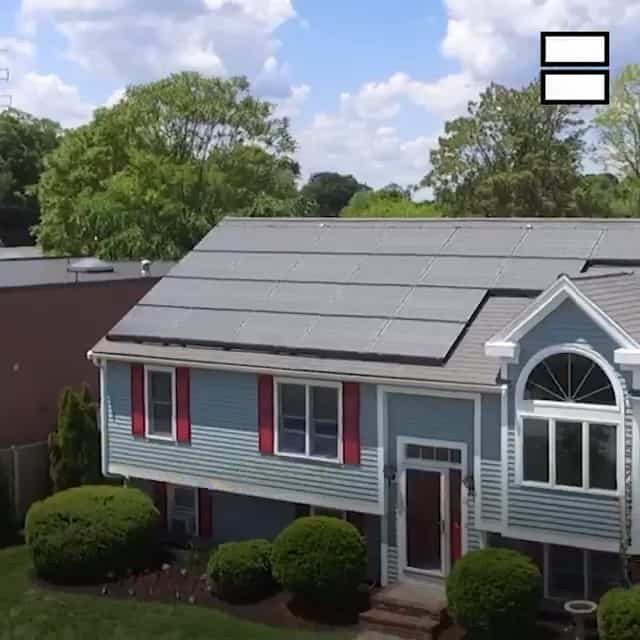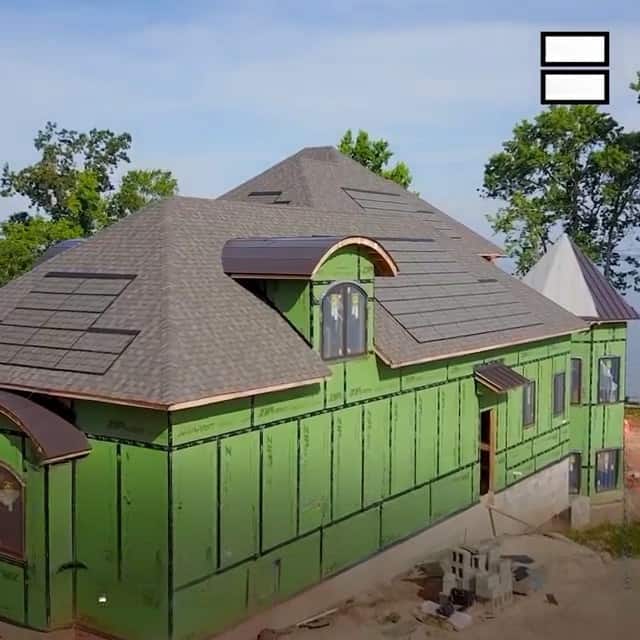Once a niche domain for the environmentally conscious, solar energy has become a mainstream powerhouse. But as more homeowners are drawn to the allure of sustainable energy, a new challenge arises: how do we integrate these gleaming panels into our homes without compromising aesthetics? Enter the world of solar panel skins, a breakthrough that marries functionality with design.
This innovation seeks to preserve our homes’ visual integrity and addresses a significant obstacle in the solar adoption journey. So, how do these solar skins work, and are they really the game-changer they promise to be? Dive in as we unravel the magic behind this technology and explore if your rooftop’s next upgrade could be stylish and sustainable.
What Are Solar Skins?

Solar skins are an innovative solution designed to enhance the visual appeal of solar panels. They are thin films overlaid on standard solar panels, bearing printed designs or patterns, often made to mimic the look of a rooftop, be it shingles, tiles, or another type of material. The primary objective is to make the panels blend seamlessly into their surroundings, making them less noticeable or obtrusive.
What sets solar skins apart from other aesthetic solutions is that while they change the appearance of the panels, they are designed to have a negligible impact on the efficiency of the underlying solar cells. These skins are made from durable materials and can withstand various environmental conditions, ensuring they last as long as the solar panels.
With the rise of solar skins, homeowners no longer have to choose between a sustainable energy source and maintaining the aesthetic appeal of their property; they can have both.
Benefits of Solar Skins

The transition to renewable energy is about addressing environmental concerns and seamlessly integrating these technologies into our daily lives. Solar skins, with their blend of design and efficiency, represent a significant stride in this direction. Let’s delve into some of their most notable benefits:
1. Aesthetic Integration: The primary advantage of solar skins is their ability to harmonize with their surroundings. Homeowners often need help to install traditional solar panels, fearing they might stand out or disrupt the visual appeal of their homes. With customizable patterns and images, solar skins negate this concern, making solar installations more appealing to a broader audience.
2. Functionality Preserved: It’s one thing to make solar panels look good, but another without compromising their core function: energy production. Solar skins use selective light filtration technology to ensure that the bulk of sunlight still reaches the underlying photovoltaic cells. Whether it’s Sistine Solar’s SolarSkin or the quantum dot-infused variant, the efficiency drop is minimal, offering homeowners a beautiful and practical energy solution.
3. Flexible Application: Quantum dot solar cells, in particular, offer a level of flexibility that’s revolutionary. This adaptability means they can be applied to a broader range of surfaces, potentially opening doors for more innovative solar applications. Imagine vehicles, windows, or gadgets wrapped in this “solar skin,” turning them into energy-harvesting entities.
4. Increased Adoption: As more homeowners become open to the idea of solar energy but wish to maintain the aesthetics of their properties, solar skins could be the answer. By providing an option combining the best design and efficiency, the adoption rate of solar technology may see a significant boost.
Solar skins stand at the confluence of design and technology, ensuring that our transition to cleaner energy sources does not come at the cost of aesthetic appeal. They represent a promising future where sustainability and design go hand in hand.
How Solar Skins Work
Solar skins are a fascinating blend of design and technology aimed at maintaining the functionality of solar panels while enhancing their aesthetic appeal. Here’s a breakdown of how they operate:
1. Layer Composition: At their core, solar skins are thin overlays applied on top of standard solar panels. These overlays have patterns or images designed to match various backgrounds, most commonly roofing materials.
2. Selective Light Filtration Technology: The underlying principle behind solar skins is selective light filtration. Just like particular sunglasses allow some light wavelengths to pass through while blocking others, solar skins are designed to filter in the sunlight necessary for photovoltaic conversion while reflecting the light that produces the desired aesthetic image. In other words, they ensure enough sunlight to power the solar cell while simultaneously displaying a chosen design.
3. Customization: The design or image on the solar skin can be tailored to an individual’s preference. The customization options are vast, whether it’s to match the surrounding roof tiles, grass for a ground installation, or any other desired design. This flexibility in design is achieved through high-resolution printing techniques.
4. Efficiency Maintenance: One might wonder if adding an extra layer to a solar panel would reduce efficiency. While there’s a minor reduction, advancements in the technology behind solar skins have ensured that this impact is minimal. The transparency and light filtration properties are optimized so that most sunlight reaches the photovoltaic cells below.
5. Durability: Solar skins are designed to last. Made from materials that can withstand varying weather conditions, they endure alongside the life of the solar panels themselves, ensuring homeowners don’t need to replace them frequently.
Solar skins offer a visual camouflage without significantly sacrificing the performance of the solar panels. They bridge the gap between sustainable energy and the desire for aesthetically pleasing home and urban designs.
Top Brands and Manufacturers of Solar Skins
Solar skins are a relatively new technology; a few top brands and manufacturers are in the market. Sistine Solar is a crucial player in the solar skin industry, having developed the patented SolarSkin technology.
They work with top solar technology companies such as Solaria, LG, Samsung, and Q CELLS to provide high-quality solar panels equipped with SolarSkins.
Other companies that use solar panels with Sistine Solar’s solar skins include LG Electronics, Solaria Corporation, Canadian Solar, Trina Solar, Q CELLS, and SunPower Corporation.
What Is the Cost of Solar Skins

The cost of solar skins varies depending on the manufacturer and the specific solar panel power system. Sistine Solar, the key player in the solar skin industry, states that their SolarSkin technology adds about 10% to the total cost of a solar system. For example, if a typical solar panel system costs around $17,000, adding SolarSkin would increase the cost to approximately $18,700. Remember that these costs are before any incentives or rebates are applied.
How do solar skins affect the lifespan of solar panels?
Solar skins can have a positive impact on the lifespan of solar panels. The layer of film that solar skins provide can protect the underlying arrays from UV corrosion and chemical degradation, increasing the durability of solar panels. However, solar skins can slightly impact solar panels’ efficiency, which can affect their lifespan over time. The average lifespan of solar panels is about 25 to 30 years.
During this period, the efficiency of solar panels will slowly decrease until they eventually reach a point where the solar panels don’t create enough electricity for all of your home’s needs. The impact of solar skins on the lifespan of solar panels has yet to be fully understood. Still, it is expected that the protective layer of film can help to extend the lifespan of solar panels.
Does Solar Skin Affect the Efficiency of Solar Panels?
The typical efficiency loss when using solar skins varies depending on the design and technology. Solar panels with SolarSkin, developed by Sistine Solar, retain about 85% to 95% of their stated energy production, depending on the customer’s choice. Solar panels with solar skins can achieve efficiency rates of about 15% to 17%, considered equal to or even a little better than the average commercially available panel. The impact on efficiency can be mitigated by strategic placement and design choices.
Solar Skins Pros and Cons
Solar skins have generated considerable interest for their innovative approach to merging aesthetics with solar technology. However, like any other technology, they come with advantages and disadvantages. Here’s a breakdown:
Pros of Solar Skins:
- Aesthetic Appeal: Solar skins offer an attractive solution for homeowners and businesses concerned about the visual impact of traditional solar panels. With customized designs, these skins can make panels blend seamlessly with the surrounding roof or environment.
- Increased Adoption: By addressing aesthetic concerns, solar skins can promote a broader acceptance of solar technology in residential areas or places where appearance is of paramount importance.
- Customization: Solar skins can be tailored to match a wide variety of roofing materials or other designs, giving property owners greater control over the look of their solar installations.
- Durability: High-quality solar skins are built to withstand various environmental conditions, ensuring they last as long as the solar panels.
- Minimal Efficiency Loss: While there’s some loss in efficiency due to the added layer, advancements in technology have reduced this impact, making it relatively minor in many cases.
Cons of Solar Skins:
- Cost Implication: Solar skins can increase the initial investment cost of a solar installation. Depending on the level of customization and the manufacturer, these costs can be significant.
- Slight Efficiency Reduction: Even with advancements, adding an additional layer to a solar panel can reduce its efficiency, even if it’s just a tiny percentage.
- New Technology: A relatively new innovation, long-term data on the performance, durability, and potential issues related to solar skins is still emerging.
- Maintenance Considerations: Any added component to a solar system could introduce new maintenance considerations or potential points of failure, though this largely depends on the quality and installation of the product.
- Limited Availability: Not all solar installation companies offer solar skins, or they offer only specific brands or designs, potentially limiting choices for consumers.
How to install Solar Skins
Installing solar skins is a specialized process that often requires professional expertise, especially when ensuring optimal performance and aesthetics of the solar panels. Here’s a general overview of how solar skins are installed:
1. Pre-installation Assessment:
- Before beginning the installation, it’s crucial to evaluate the area where the panels will be installed, ensuring there’s no damage, debris, or other obstructions.
- Determine the orientation and tilt of the solar panels to maximize solar exposure.
2. Clean the Solar Panels:
- Before applying the solar skins, ensure the solar panels are thoroughly cleaned. Any dust or debris can affect the skins’ adherence and the panels’ efficiency.
3. Positioning the Solar Skin:
- Roll out or position the solar skin atop the panel, aligning it correctly with its edges.
- Make sure there are no bubbles, wrinkles, or misalignments.
4. Adhere to the Solar Skin:
- Depending on the manufacturer’s design, the solar skin may adhere directly or require a specific adhesive. Follow the manufacturer’s instructions closely.
- Use a squeegee or a similar tool to press the skin onto the panel, removing any bubbles and ensuring a firm, even adherence.
5. Trim Excess:
- If there’s any excess material around the edges, it should be carefully trimmed. This ensures the skin fits perfectly and doesn’t interfere with the panel’s framing or mounting.
6. Connect the Panels:
- Once the skins are in place, proceed with the panel connections. This involves connecting the panels to inverters, batteries, or the grid.
7. Testing:
- After installation, test the system to ensure that the panels are generating power efficiently and that there are no issues with power transmission.
8. Monitor Performance:
- Especially in the initial days after installation, monitor the panels’ performance. Ensure the solar skins aren’t negatively impacting the efficiency.
9. Regular Maintenance:
- As with any solar installation, regular maintenance and cleaning are essential. Ensure the skins remain clean and free of debris to maintain optimal efficiency.
Note: While the steps above provide a general overview, consulting with a professional or the solar skin manufacturer for specific installation guidelines is essential. The nuances and specific steps can vary based on the solar skin brand, the type of solar panels you have, and your home’s specific conditions. If you’re not experienced with solar installations, hiring professionals to ensure the skins are installed correctly and safely is advisable.
In conclusion, while solar skins present a captivating solution to the aesthetic challenges of solar installations, potential adopters must weigh the benefits against the drawbacks and make informed decisions based on their unique needs and priorities.
